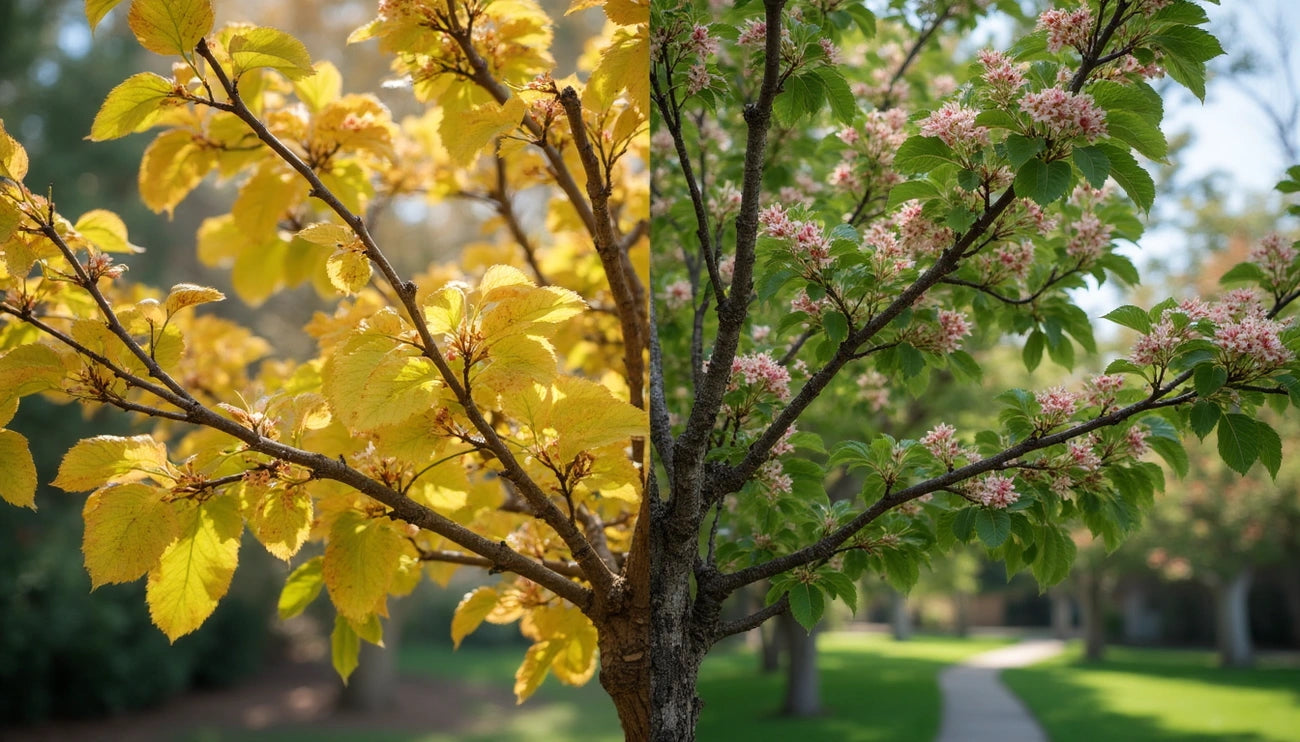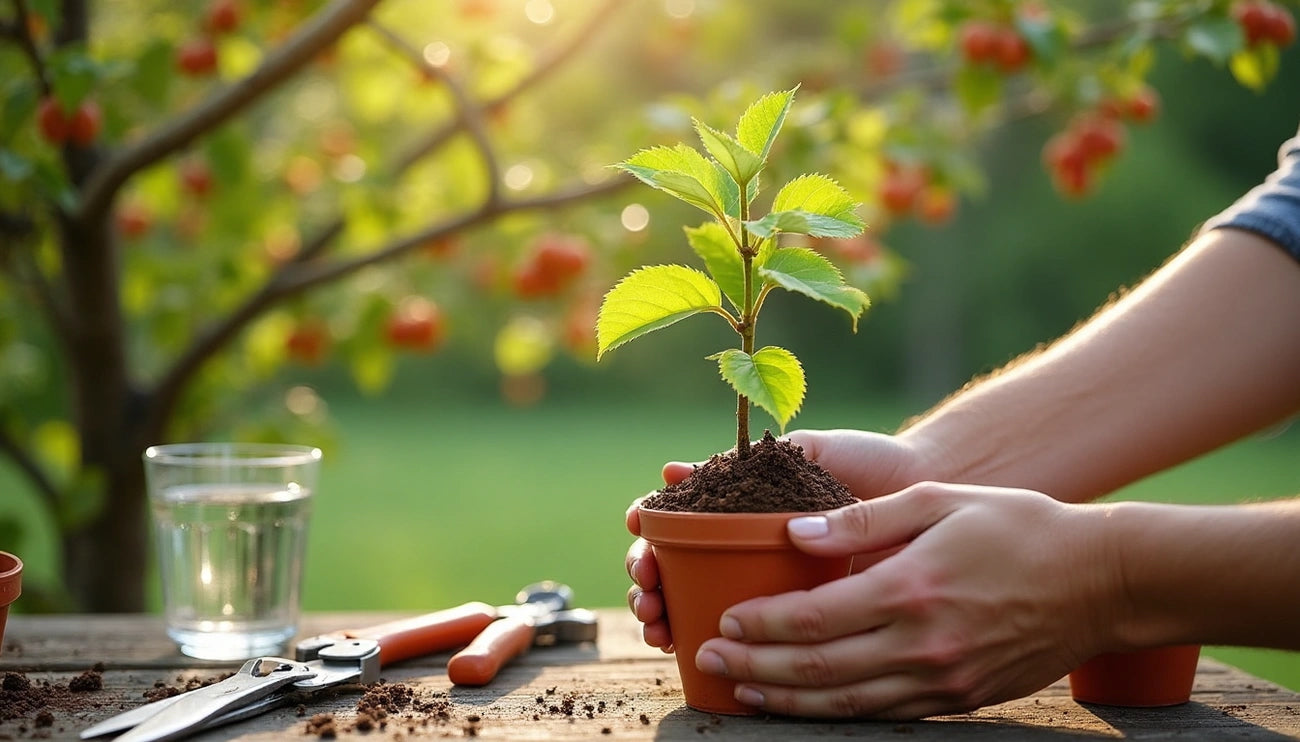How deep are crabapple tree roots? This question is essential for anyone considering adding these beautiful trees to their landscape. With more than 500 different varieties of crabapple trees available, understanding their root structure helps ensure proper planting and prevents future problems.
Surprisingly, crabapple tree roots typically extend only about 2 to 3 feet into the ground. The size of a mature crabapple tree's root system is neither aggressive nor invasive, making these trees suitable for many residential settings. While the majority of crabapple roots are surface roots, concentrating in the top 24 inches of soil or even the top 12 inches, there are also deeper sections that anchor the tree securely.
In this comprehensive guide, we'll explore everything you need to know about crabapple tree root systems. We'll examine how far these roots spread horizontally, discuss safe planting distances from structures, and provide expert tips for managing potential root issues. Whether you're planning to plant a new crabapple tree or managing existing ones, this information will help you make informed decisions for your landscape.
How crabapple tree roots grow
Crabapple tree root systems follow a fascinating growth pattern that makes them ideal for many landscape settings. Understanding their structure helps in making informed planting decisions.
Feeder roots vs structural roots
Crabapple trees, like apple trees, develop two primary root types that work together to support the tree. Structural roots extend laterally from the trunk and serve as the tree's anchor, providing stability during adverse weather conditions. These woody roots form the framework of the root system and play crucial roles in transporting water, minerals, and organic compounds throughout the tree.
In contrast, feeder roots (more accurately called absorbing roots) spread horizontally near the soil surface and perform the vital function of capturing water and essential nutrients. These nonwoody roots store significant amounts of carbohydrates in specialized units called amyloplasts. Contrary to common belief, absorbing roots extend well beyond the tree's drip line, with mature trees having feeder roots reaching two to three times the distance from the trunk to the branch tips.
Do crabapple trees have deep roots?
Essentially, crabapple trees do not develop deep root systems. The majority of their roots concentrate in the top 24 inches of soil. This shallow rooting pattern occurs because most nutrients and water are found in the uppermost layers of soil. Furthermore, the concept of "shallow-rooted" versus "deep-rooted" trees is not factually accurate.
Most trees, including crabapples, grow their roots horizontally rather than vertically. Crabapples are not known for having invasive root systems, making them suitable for residential landscapes where space might be limited.
How root systems adapt to soil
Notably, crabapple tree roots demonstrate remarkable adaptability across various soil conditions. When planted in oxygen-deficient or waterlogged soils, roots will respond by growing closer to the surface. Consequently, roots may become more visible at the soil surface in compacted urban environments.
Root development depends significantly on soil temperature, with optimal growth occurring between 15 and 27°C. Below or above this range, water and nutrient uptake is affected, and root morphology may change. Root systems perform best in well-drained, fertile soil without barriers like rocks or compacted layers that can restrict development.
When grown in containers versus open ground, crabapples develop distinctly different root architectures. Field-grown trees typically have fewer root defects and more roots extending into the surrounding landscape after transplanting.
How far do crabapple tree roots spread
The horizontal spread of crabapple roots often surprises gardeners who underestimate their reach. Unlike the common misconception that roots only extend to the dripline, research reveals a much more extensive underground network.
Understanding the dripline and root radius
Many gardeners mistakenly believe tree roots only grow to the branch tips or dripline. However, scientific research thoroughly debunks this myth. In reality, most crabapple tree roots extend far beyond this visible boundary. Studies show that tree roots typically spread two to three times the radius of the tree's canopy or dripline. This extensive reach has significant implications for planting decisions and landscape management.
Research examining entire root systems of various trees found that all species had greater root length outside the branch dripline than within. For apple trees specifically, reports from as early as 1934 confirmed that root systems extended far beyond the branches. Therefore, when planning your landscape, remember that the roots of your crabapple tree are spreading much wider than you might expect.
Impact of tree size on root spread
The overall size of your crabapple directly influences its root spread. To calculate your tree's potential root reach, first measure from the trunk to the dripline, then multiply this distance by 2-3 to estimate feeder root extension. For instance, if your crabapple's dripline is 8 feet from the trunk, expect roots to extend 16-24 feet from the trunk.
For precise calculations, you can determine the root area using the formula: A = 3.14 × r², where r is the average root radius. With a 20-foot root radius, that equals approximately 1,200 square feet of root area.
Root behavior in containers vs open ground
Interestingly, container-grown and field-grown crabapples develop distinctly different root systems. Field-grown trees typically develop root systems that extend radially from the trunk without interruption at the interface of the original root ball and surrounding soil. The largest roots generally form near the soil surface.
Conversely, trees from plastic container systems often exhibit root defects, including circling and bent roots at the original root ball perimeters. These differences persist after transplanting, affecting long-term growth patterns and stability.
Safe planting practices for crabapple trees
Proper planting ensures your crabapple tree thrives for decades without causing problems to nearby structures. Considering what we know about their root systems, let's explore best practices for successful planting.
Ideal distance from driveways and foundations
Plant crabapple trees approximately 8 to 10 feet away from buildings or garden walls. For two-story structures, increase this distance to 15 feet to accommodate mature canopy growth. Crabapples can be successfully planted in narrow spaces between sidewalks and streets (minimum 4 feet wide) or in 4 to 6-foot-wide planters. Their non-invasive root systems make them safer near foundations than many other tree species.
How to dig the right planting hole
First, dig a hole twice as wide as the root ball. The depth should allow the top of the rootball to sit slightly above ground level. Loosen soil at the bottom and sides of the hole. Position the tree so the crown or graft is level with or slightly higher than the surrounding grade. After planting, create a water-retaining berm around the tree.
Spacing between multiple trees
Space multiple crabapple trees 10 to 20 feet apart, depending on the variety's mature size. For dense privacy screens using narrow varieties, you can reduce spacing to 6 to 15 feet. Closer spacing encourages trees to grow taller and narrower. Browse our selection of crabapple trees to find varieties perfectly suited for your specific landscape needs.
Common concerns and root management tips
Managing crabapple tree roots effectively prevents potential issues with your landscape. Let's address some common concerns that homeowners face with these beautiful trees.
Can crabapple roots damage pavement?
Fortunately, crabapple trees are among the safer options near hardscapes. Their roots typically won't break building foundations unless the foundation is already cracked or leaking. The Adams Crabapple variety specifically won't damage sidewalks and adds visual appeal to parking lots. For optimal results, plant crabapples at least 8-10 feet away from buildings.
How to prevent surface roots
Surface roots often appear when trees struggle to breathe in compacted soil. Avoid cutting visible roots, as this creates entry points for diseases and reduces stability. Instead, consider topdressing with a mixture of equal parts topsoil and compost, applying no more than two inches at a time. Alternatively, adding four inches of wood chip mulch helps level the area while keeping roots cool and oxygenated.
Best soil types for healthy root growth
Crabapples prefer slightly acidic, rich soil with good drainage. Add organic amendments like peat moss and coffee grounds when planting to maintain appropriate pH levels. Natural mulch benefits these trees, whereas surrounding turf lawns may increase susceptibility to fungus and pests.
When and how to prune safely
Prune during late winter or early spring while the tree is dormant but after severe cold has passed. First remove suckers (shoots from the base) and water sprouts (small angled shoots between branches). Browse our selection of crabapple trees that respond well to proper pruning techniques. Limit pruning to 20% of the canopy in a single season. For larger branches, wait until late fall and use a pruning saw.
Conclusion
Understanding the root system of crabapple trees certainly makes planting decisions much easier. These ornamental trees offer a perfect balance between beauty and practicality with their shallow, non-invasive roots. Generally, most crabapple roots remain in the top 24 inches of soil while extending horizontally two to three times beyond the visible canopy.
This knowledge allows us to plant crabapples confidently near structures without fear of foundation damage. Maintaining proper distances—8 to 10 feet from buildings and 10 to 20 feet between multiple trees—ensures both safety and optimal growth. Additionally, their adaptability to various soil conditions makes these trees versatile additions to almost any landscape.
Safe planting practices include digging holes twice as wide as the root ball and ensuring proper depth. Afterwards, regular maintenance through appropriate mulching and careful pruning helps manage surface roots and promotes overall tree health.
Crabapple trees thus prove themselves valuable landscape elements due to their manageable root systems. Their combination of shallow depth and predictable horizontal spread eliminates many common concerns associated with tree planting. Therefore, you can enjoy their stunning seasonal displays without worrying about structural damage or excessive maintenance. Before planting, remember to measure your available space carefully and select a variety that fits your specific landscape requirements for years of trouble-free growth.
FAQs
Q1. How deep do crabapple tree roots typically grow? Crabapple tree roots are generally shallow, with the majority concentrated in the top 24 inches of soil. They typically extend only about 2 to 3 feet into the ground.
Q2. Is it safe to plant crabapple trees near buildings? Yes, it's generally safe to plant crabapple trees near buildings. Their non-invasive root systems make them a good choice for residential settings. It's recommended to plant them 8 to 10 feet away from structures for optimal growth and to prevent any potential issues.
Q3. How far do crabapple tree roots spread horizontally? Crabapple tree roots typically spread two to three times the radius of the tree's canopy. For example, if a tree's dripline is 8 feet from the trunk, you can expect roots to extend 16-24 feet from the trunk.
Q4. What type of soil is best for crabapple trees? Crabapple trees prefer slightly acidic, rich soil with good drainage. Adding organic amendments like peat moss and coffee grounds when planting can help maintain appropriate pH levels and promote healthy root growth.
Q5. When is the best time to prune crabapple trees? The best time to prune crabapple trees is during late winter or early spring while the tree is dormant but after severe cold has passed. Limit pruning to 20% of the canopy in a single season to maintain the tree's health and shape.




Leave a comment
This site is protected by hCaptcha and the hCaptcha Privacy Policy and Terms of Service apply.